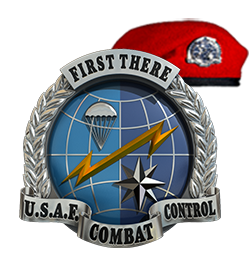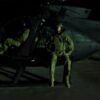Combat Control at War
Combat Control Teams evolved from Army Pathfinders originating in 1943 out of the need for accurate airdrops during airborne campaigns of World War II. These pathfinders preceded main assault forces into objective areas to provide weather information and visual guidance to inbound aircraft through the use of high-powered lights, flares and smoke pots.
When the Air Force became a separate service, Air Force Pathfinders, later called Combat Control Teams, were activated in 1953 to provide navigational aids and air traffic control for a growing Air Force. In the Vietnam War, combat controllers helped assure mission safety and expedited air traffic flow during countless airlifts. Combat controllers also flew as forward air guides in support of indigenous forces in Laos and Cambodia.
Combat Controllers continue to be "First There" when they are called upon to participate in direct action intervention, international emergencies and humanitarian relief efforts.
March 24, 1945 - Operation Varsity
Near the end of 1944, the U.S. Army Air Force (USAAF) developed glider-borne teams; calling them Combat Control Teams. Unlike earlier U.S. Army Pathfinders, the new Combat Control Teams were provisioned with visual markers; ground-to-air and point-to-point radios; and electronic navigational aids (NAVAIDS), e.g., the Eureka radar homing beacon. Additionally, the newly commissioned Air Force teams were charged with the responsibility of airhead air traffic control (AATC).
AATC required these new combat teams to coordinate terminal guidance for aircraft arriving at an assault zone and air traffic control of aircraft transiting the airhead.
In later years, AATC added new responsibilities for coordinating the high-altitude firing – by allied artillery batteries and issuing intelligence advisories about enemy positions in the vicinity of the airhead. The USAAF Combat Control Teams’ first test would come during Operation Varsity on March 24, 1945.
On that day, eight Air Force teams were infiltrated across the Rhine, ahead of XVIII Airborne Corps’ forces in the first airborne assault on Nazi Germany. USAAF aircraft subsequently delivered airborne and glider-borne troops near the town of Wesel, in western Germany.
Operation Varsity delivered more than 16,000 paratroopers, employed several thousand aircraft and was the largest single airborne operation in history to be conducted on a single day and in one location. “The Combat Control Teams, after undergoing some operational streamlining, would find their most effective and extensive application in the later stages of the war as Airfield Control Teams (ACT). The ACTs coordinated the use of the crowded skies and airfields in Germany that were taken over by IX Troop Carrier Command for re-supplying the rapidly-advancing allied armored columns. (Wikipedia)
“Into the Valley” - The Untold Story of USAAF Troop Carrier in WWII
Colonel Charles H. Young - PrintComm, Inc., Dallas, TX, 1995. ISBN 0-9647978-0-1.
CCT in World War II through Vietnam, Cambodia, and beyond
Following WWII and the heritage created by the Pathfinders, the establishment of the U.S. Air Force as a separate service on 18 September 1947 brought organizational changes resulting in tactical airlift and aerial port squadrons assuming responsibility for support of the U.S. Army ground forces. Air Force pathfinder teams, later called Combat Control Teams, were activated in January of 1953 to provide navigational aids and air traffic control for the growing airlift forces.
Since their activation, combat controllers have made many contributions to Air Force operations worldwide. Combat controllers participated and distinguished themselves in the Southeast Asia conflict including the evacuation of Vietnam and Cambodia, in the Lebanon crisis (Jul- Oct ’58), the Congo crisis (Jul-Oct ’60 ), the Cuban crisis (Sep ’62), the China-India confrontation (Nov ’62 – Sep ’63), the Dominican Republic contingency, through todays global war on terror.
CCT in Todays War on Global Terror
Combat controllers were a part of the pre-strike build up of the United Nation coalition during operation Desert Shield, and heavily involved in the air traffic control, air-to-ground operations, and assault actions that liberated Kuwait from Iraq during the ensuing Desert Storm campaign. Combat controllers also provided extensive air traffic control for the airlift that provided humanitarian relief to Kurdish refugees fleeing into northern Iraq.
CCT members have played an important role in the War-On-Terror. Since 9/11 combat controllers and a special tactics officer have earned Air Force Cross Medals for extraordinary heroism in combat operations, and more have earned the Silver Star.


